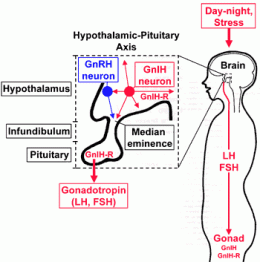New human reproductive hormone could lead to novel contraceptives

(PhysOrg.com) -- Nearly 10 years after the discovery that birds make a hormone that suppresses reproduction, University of California, Berkeley, neuroscientists have established that humans make it too, opening the door to development of a new class of contraceptive and possible treatments for cancer or other diseases.
The hormone, gonadotropin inhibitory hormone (GnIH), has the opposite effect from gonadotropin releasing hormone, a key reproductive hormone. While GnRH triggers a cascade of hormones that prime the body for sex and procreation, GnIH puts a brake on the cascade.
"Identifying the inhibitory hormone in humans forces us to revise our understanding of the control mechanism of human reproduction," said first author Takayoshi Ubuka, a post-doctoral fellow in the UC Berkeley Department of Integrative Biology and in the Helen Wills Neuroscience Institute. "We hope this will stimulate clinical studies on people with precocious puberty or in the area of contraception."
Because reproductive hormones often promote the growth of cancer cells, GnIH might also work as an anti-cancer agent.
"Frequently, treatment of hormone-responsive cancers involves GnRH antagonists or very, very high doses of GnRH, which cause side effects," said George Bentley, UC Berkeley assistant professor of integrative biology. "Maybe we can use something that inhibits reproduction at physiological levels, so that we can bypass some of these side effects."
Ubuka, Bentley and their colleagues at UC Berkeley and in Japan and the United Kingdom report their findings in the Dec. 22 online issue of the public access journal PLoS ONE.
GnIH was discovered in 2000 in quail and has been studied in other birds, in mice and in sheep, but its role in humans has been hard to pin down. While the human genome contains the gene for GnIH, it was unclear if, when and where the protein hormone is produced, and whether it affects reproduction.
The UC Berkeley researchers extracted two versions of the hormone from human brains (five human hypothalami). They found that the human GnIH gene produces a precursor protein that is cut up to form 12 and 8 amino acid mature peptides.
"One of the peptides in sheep has the same amino acid sequence as the human peptide, so we can study its activity in sheep to learn about its activity in humans," Bentley said. "It's likely that the function of GnIH is evolutionarily conserved."
They also showed that the hormones are present in a region of the brain, the hypothalamus, that controls reproduction. In addition, GnIH affects nerve cells that secrete GnRH, which is in line with previous findings that GnIH down-regulates GnRH.
Finally, they found that the hypothalamus and pituitary - two key parts of the reproductive axis in the brain have receptors for the hormones.
All the previous work on birds, rodents, sheep and even macaque monkeys - much of it performed by Bentley's group and by a group led by the discoverer of GnIH, Kazuyoshi Tsutsui at Waseda University in Tokyo hint at a wealth of interactions between GnIH and the reproductive system. Only recently, the human hormone was shown to inhibit the release of gonadotropin in sheep.
"GnIH pushes the pause button on reproduction, but in a variety of ways," Bentley said. "It can act on GnRH neurons in the hypothalamus, inhibiting GnRH release; it can act directly on pituitary; or it can influence the gonads directly. The overall effect is to inhibit reproduction, but at different levels of the reproductive axis."
GnIH might even be a key regulator of puberty, Ubuka said.
Bentley and Ubuka continue to investigate how GnIH acts in humans as well as in starlings and zebra finches.

















